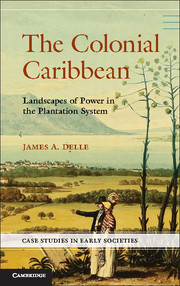Book contents
- Frontmatter
- Contents
- Figures
- Tables
- Preface
- 1 Landscapes of Power in the Colonial Caribbean
- 2 His Majesty’s Island
- 3 The Plantation Mode of Production
- 4 A Class for Itself: Regional Landscapes of the Planter Class
- 5 Contradictions and Dialectics: Village Landscapes of the Enslaved
- 6 Dialectics and Social Change: Plantation Landscapes after Slavery
- 7 Plantation Landscapes in Comparative Perspective
- 8 Conclusion
- References
- Index
2 - His Majesty’s Island
The Colonial World of Plantation Jamaica
Published online by Cambridge University Press: 05 June 2014
- Frontmatter
- Contents
- Figures
- Tables
- Preface
- 1 Landscapes of Power in the Colonial Caribbean
- 2 His Majesty’s Island
- 3 The Plantation Mode of Production
- 4 A Class for Itself: Regional Landscapes of the Planter Class
- 5 Contradictions and Dialectics: Village Landscapes of the Enslaved
- 6 Dialectics and Social Change: Plantation Landscapes after Slavery
- 7 Plantation Landscapes in Comparative Perspective
- 8 Conclusion
- References
- Index
Summary
Of all the regions around the world that have been at one time or another subject to European colonial rule, none, perhaps, is as diverse in experience and history as the Caribbean. A great archipelago stretching from the south coast of Florida to the east coast of Venezuela, the region has been described as a “continent of islands” (Kurlansky 1993). Comprised of small sand spits, active volcanoes, long white sand beaches, and rugged mountains, over the millennia the Caribbean islands developed geographic, faunal, and botanical diversity that has long inspired the imaginations of visitors (see Figure 2.1).
The human diversity of the modern Caribbean has developed as a consequence of several thousand years of human colonization. Caribbean archaeologists now believe that the indigenous peoples of the Caribbean spread out across the islands in multiple waves of migration, developing complex political and economic relationships within and between islands (e.g., Keegan and Atkinson 2006; Rouse 1992; Wilson 2007). Entering the European imagination in the decades following Columbus’s famous landfall in 1492, the Caribbean experienced many waves of European colonial settlement. European adventurers from all of the maritime nations of Western Europe – Spain, Portugal, England, France, Denmark, Holland, Scotland, Ireland, and Sweden – eventually claimed islands for their sovereigns and set out to seek fortunes for themselves. Early on, many of those fortunes were built through the exploitation of local indigenous peoples; by the end of the seventeenth century, those fortunes were nearly uniformly dependent on the exportation of tropical crops including tobacco, cotton, coffee, and above all, sugar (Craton 1997; Dunn 2000; Tomich 1990, 2004; Walvin 1997).
- Type
- Chapter
- Information
- The Colonial CaribbeanLandscapes of Power in Jamaica's Plantation System, pp. 22 - 63Publisher: Cambridge University PressPrint publication year: 2014

